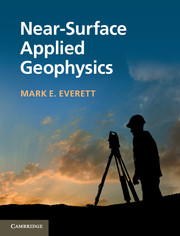Refine listing
Actions for selected content:
1211 results in Ebooks in petroleum sciences
Acknowledgments
-
- Book:
- Near-Surface Applied Geophysics
- Published online:
- 05 April 2013
- Print publication:
- 25 April 2013, pp xiv-xiv
-
- Chapter
- Export citation
1 - Introduction
-
- Book:
- Near-Surface Applied Geophysics
- Published online:
- 05 April 2013
- Print publication:
- 25 April 2013, pp 1-11
-
- Chapter
- Export citation
Appendix D - Horizontal loop over a conducting halfspace
-
- Book:
- Near-Surface Applied Geophysics
- Published online:
- 05 April 2013
- Print publication:
- 25 April 2013, pp 370-376
-
- Chapter
- Export citation
12 - Non-linear inversion: local methods
-
- Book:
- Near-Surface Applied Geophysics
- Published online:
- 05 April 2013
- Print publication:
- 25 April 2013, pp 317-336
-
- Chapter
- Export citation

Near-Surface Applied Geophysics
-
- Published online:
- 05 April 2013
- Print publication:
- 25 April 2013
5 - Mesoscale models for physical and chemical processes
-
- Book:
- Computational Models for Polydisperse Particulate and Multiphase Systems
- Published online:
- 05 March 2013
- Print publication:
- 28 March 2013, pp 136-213
-
- Chapter
- Export citation
1 - Introduction
-
- Book:
- Computational Models for Polydisperse Particulate and Multiphase Systems
- Published online:
- 05 March 2013
- Print publication:
- 28 March 2013, pp 1-29
-
- Chapter
- Export citation
2 - Mesoscale description of polydisperse systems
-
- Book:
- Computational Models for Polydisperse Particulate and Multiphase Systems
- Published online:
- 05 March 2013
- Print publication:
- 28 March 2013, pp 30-46
-
- Chapter
- Export citation
Appendix A - Moment-inversion algorithms
-
- Book:
- Computational Models for Polydisperse Particulate and Multiphase Systems
- Published online:
- 05 March 2013
- Print publication:
- 28 March 2013, pp 403-420
-
- Chapter
- Export citation
8 - Moment methods for inhomogeneous systems
-
- Book:
- Computational Models for Polydisperse Particulate and Multiphase Systems
- Published online:
- 05 March 2013
- Print publication:
- 28 March 2013, pp 329-402
-
- Chapter
- Export citation
3 - Quadrature-based moment methods
-
- Book:
- Computational Models for Polydisperse Particulate and Multiphase Systems
- Published online:
- 05 March 2013
- Print publication:
- 28 March 2013, pp 47-101
-
- Chapter
- Export citation
Contents
-
- Book:
- Computational Models for Polydisperse Particulate and Multiphase Systems
- Published online:
- 05 March 2013
- Print publication:
- 28 March 2013, pp vii-xii
-
- Chapter
- Export citation
References
-
- Book:
- Computational Models for Polydisperse Particulate and Multiphase Systems
- Published online:
- 05 March 2013
- Print publication:
- 28 March 2013, pp 459-487
-
- Chapter
- Export citation
Index
-
- Book:
- Computational Models for Polydisperse Particulate and Multiphase Systems
- Published online:
- 05 March 2013
- Print publication:
- 28 March 2013, pp 488-508
-
- Chapter
- Export citation
Appendix C - Moment methods with hyperbolic equations
-
- Book:
- Computational Models for Polydisperse Particulate and Multiphase Systems
- Published online:
- 05 March 2013
- Print publication:
- 28 March 2013, pp 441-449
-
- Chapter
- Export citation
Notation
-
- Book:
- Computational Models for Polydisperse Particulate and Multiphase Systems
- Published online:
- 05 March 2013
- Print publication:
- 28 March 2013, pp xvii-xxxviii
-
- Chapter
- Export citation
Appendix B - Kinetics-based finite-volume methods
-
- Book:
- Computational Models for Polydisperse Particulate and Multiphase Systems
- Published online:
- 05 March 2013
- Print publication:
- 28 March 2013, pp 421-440
-
- Chapter
- Export citation
6 - Hard-sphere collision models
-
- Book:
- Computational Models for Polydisperse Particulate and Multiphase Systems
- Published online:
- 05 March 2013
- Print publication:
- 28 March 2013, pp 214-265
-
- Chapter
- Export citation
7 - Solution methods for homogeneous systems
-
- Book:
- Computational Models for Polydisperse Particulate and Multiphase Systems
- Published online:
- 05 March 2013
- Print publication:
- 28 March 2013, pp 266-328
-
- Chapter
- Export citation
Appendix D - The direct quadrature method of moments fully conservative
-
- Book:
- Computational Models for Polydisperse Particulate and Multiphase Systems
- Published online:
- 05 March 2013
- Print publication:
- 28 March 2013, pp 450-458
-
- Chapter
- Export citation
